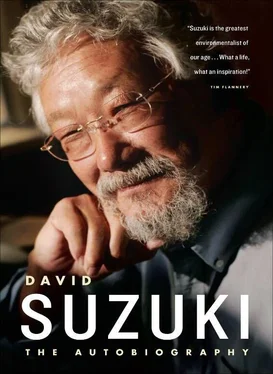If we were to reduce the planet to the size of a basketball, the atmosphere would be thinner than a layer of plastic we use to wrap sandwiches. And that is what we pour our effluents into every time we drive a car and every time our factories send pollutants through their smokestacks.
More than three billion years ago, plants appeared and began to photosynthesize, taking up carbon dioxide and combining it with water and energy from the sun to begin the process of carbon chain formation, which generates all of the molecules necessary for life. A byproduct of the chemical reactions in this process was oxygen. Before there were plants, the atmosphere was toxic for animals like us, since it was heavily laden with carbon dioxide and devoid of oxygen. Plants created the oxygen-rich atmosphere on which we depend and removed the carbon dioxide generated as part of respiration to keep the amount of carbon dioxide in the atmosphere at about 280 parts per million (ppm). But for more than a century, modern industrial activities have generated so much carbon dioxide from burning fossil fuels that all the plants on land and in the oceans can't keep up with it, and carbon dioxide has been accumulating in the atmosphere.
The fundamental mechanism of global warming is not contentious. Naturally occurring molecules such as water, carbon dioxide, methane, and nitrous oxide reflect infrared or heat waves. These molecules in the atmosphere act in the way glass on a greenhouse behaves, allowing sunlight to pass through but reflecting heat; hence these molecules are called greenhouse gases. On Mars, which has a very thin atmosphere, temperatures ricochet between the boiling heat of day and the freezing cold of night because there is no blanket of greenhouse gases to keep the heat on the planet. In contrast, Venus is permanently covered with a thick cloud of carbon dioxide, so surface temperatures are in the hundreds of degrees. Earth has had just the right combination of greenhouse gases in the atmosphere to stabilize temperatures between day and night and enable life to evolve and flourish.
Careful studies conducted in Hawaii for over fifty years have registered the unequivocal rise in atmospheric carbon dioxide levels from 280 ppm in preindustrial times to the present 362 ppm, a 32 percent increase. The upward curve in the rate of increase suggests that if we carry on with business as usual, we will double the concentration long before the end of the century. These studies also suggest that if we were to cut all our emissions by half overnight, thereby bringing our annual emissions to a level that can be reabsorbed by all photo-synthetic activity within the biosphere, it will still take hundreds of years before the temperature changes from what we have already added to the atmosphere will level out, first in the air, then on land, and finally in the oceans. In other words, we have already set in motion an experiment with Earth that will not be fully played out for many, many more generations of humans.
Since the mid-1980s, I had known that the buildup of greenhouse gases such as carbon dioxide might be on a scale sufficient to affect our climate. But I thought there were far more pressing immediate issues, like toxic pollution, deforestation, and species extinction, and that climate change was a slow-motion disaster that would not really kick in for generations. It was only in 1988, when I first visited Australia, that Phil Noyce, my host, convinced me it was an urgent issue that needed action now. In the autumn of that year, climate experts from all parts of the world, who were gathered in Toronto for a major conference on the atmosphere, warned that the threat of global warming was real and called for a reduction in greenhouse gas emissions of 20 percent in fifteen years.
That year, the World Meteorological Organization and the United Nations Environment Program established the Intergovernmental Panel on Climate Change (IPCC), made up of hundreds of climatologists from many countries, to monitor the state of global climate. Sadly, hindsight reveals that had governments responded and met that challenge beginning in 1988, the air today would be cleaner, people healthier, and fossil fuels more plentiful, and we would be saving hundreds of billions of dollars and be well along the path to achieving an emission level that could be absorbed by the biosphere.
At the height of global concern about the environment, governments and nongovernmental organizations planned the 1992 Earth Summit in Rio de Janeiro. The countries attending the summit agreed to stabilize greenhouse gas emissions at the 1990 levels by 2000, but most countries, including Canada, merely called for “voluntary compliance” with the targets. In the meantime, the fossil fuel industry launched an aggressive campaign to discredit the very idea that human activity was influencing climate, and the use of fossil fuels and thus greenhouse gas emissions continued to rise.
In 1995, to film for The Nature of Things , I attended a conference on climate organized by the Intergovernmental Panel on Climate Change in Geneva. Hundreds of IPCC climatologists from more than seventy nations had painstakingly assessed thousands of scientific papers on weather and climate, and they concluded in 1990 in their first major assessment that global climate was warming, and that the change was not part of a natural cycle. In 1995, the IPCC's second assessment concluded that “the balance of evidence suggests a discernible human influence on global climate.” Though it seemed to me a pretty tepid conclusion — in the global arena, delegates are under enormous scrutiny and pressure from groups like governments and industries — this was a powerful warning. The IPCC's third assessment, released in 2001, was even stronger.
In Geneva, I was deeply moved by two delegates I met there. One was a Kenyan farmer who said traditional farmers used the cyclical appearance and disappearance of different plants as the cues to start plowing, planting, and harvesting, but they were having difficulty because these wild indicator plants seemed to be out of phase. Here was a scientifically uneducated farmer, dependent on external signals for his livelihood, reporting signs that climate was changing. I also encountered a South American Indian who told me that even on the equator, where there are not the traditional seasons that we know, plants were behaving in strange, never-before-seen ways.
Unfortunately, these traditional people did not have PhDs and were not fluent in the jargon of science, and like the people living on tropical coral atolls threatened by rising waters and the Inuit of the Arctic reporting on melting permafrost, they were paid little heed.
The IPCC continues its work, especially refining computer models and carefully refuting the arcane objections (satellite readings fail to confirm ground level measurements, sunspots are the primary cause of warming, models have no basis in reality, et cetera) of a handful of nay-sayers, most of whom are funded by the fossil fuel industry. Overall, the enormous undertaking by the IPCC has merely made the warnings of 1988 stronger and more urgent.
Most climatologists believe the evidence is overwhelming that the atmosphere is warming unnaturally, that humans are the major contributor to this warming, and that immediate action is needed to counter the effects. Sadly, the renowned science-fiction writer Michael Crichton, author of The Andromeda Strain and Jurassic Park , has recently published a sci-fi thriller, State of Fear , based on the premise that environmental extremists are creating ecological crises to frighten people into supporting them. It is a preposterous thesis that seems to legitimate the idea that climate change is not real and does not require action.
There have been other books that purport to disprove climate change, many of them written by ideologues who dismiss environ-mentalists out of hand or who have a vested interest in industry. Gregg Easterbrook was an environmental writer for Newsweek and other publications, so his suggestion that environmentalists had been so successful that they had achieved most of their goals was taken very seriously, though it was refuted by many eminent ecologists and experts. Academic Bjørn Lomborg's book The Skeptical Environmentalist has been embraced by right-wing think tanks like the Fraser Institute in Vancouver and business organizations. Again, a great deal of effort has had to be made to counter Lomborg's claim that the state of the environment is far better than environmentalists acknowledge.
Читать дальше


![David Jagusson - Devot & Anal [Hardcore BDSM]](/books/485905/david-jagusson-devot-anal-hardcore-bdsm-thumb.webp)









